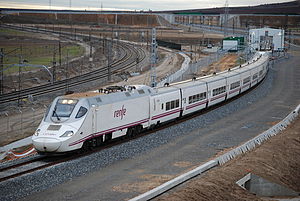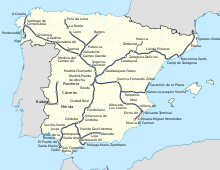| Renfe Class 130 Talgo 250 | |
|---|---|
 | |
| Manufacturer | Talgo[1] / Bombardier (Kassel)[2] |
| Number built | 45 |
| Capacity | 11 coach set: 299 seats, 236 standard, 62 first, 1 special[1] |
| Operators | Renfe Uzbek Railways |
| Specifications | |
| Train length | 183 m (600 ft 4.7 in)[1] |
| Car length | 20 m (65 ft 7.4 in) (power car)[1] 13.14 m (43 ft 1.3 in) (passenger car)[3] |
| Width | 2.96 m (9 ft 8.54 in) (power car)[1] |
| Height | 4 m (13 ft 1.48 in) (power car)[1] |
| Maximum speed | 250 km/h (160 mph) (standard gauge lines)[1] 220 km/h (140 mph) (Iberian gauge lines)[1] 180 km/h (110 mph) (S730; diesel mode) |
| Weight | 312 t |
| Axle load | max. axle load 18 t (17.7 long tons; 19.8 short tons)[1] |
| Traction system | Electric |
| Prime mover(s) | TMF 64-32-4 / 2x MTU 12V 4000 R43L (S730) |
| Power output | 2,400 kW (3,200 hp) @ 25 kV AC 2,000 kW (2,700 hp) @ 3 kV DC (per power unit)[1] 1.8 MW (2,400 hp) per power car in diesel mode (S730) |
| Electric system(s) | 25 kV 50 Hz AC / 3 kV DC[1]Catenary |
| Current collector(s) | Pantograph (2 per power car) high voltage roof mounted electrical bus between power cars.[citation needed] |
| UIC classification | Bo'Bo' 1,1,1,1,1,1,1,1,1,1,1,1 Bo'Bo' (11 car set) |
| Bogies | BoBo (power car)[1] Articulated independent wheel 'single axle' in passenger cars[1] |
| Braking system(s) | 2 disc brakes per axle regenerative and rheostatic brakes in power cars[1] pneumatic discs in passenger cars[1] |
| Track gauge | 1,435 mm (4 ft 8+1⁄2 in) / 1,668 mm (5 ft 5+21⁄32 in)[1] |
The Renfe Class 130 or S-130[4] (Spanish: Serie 130 de Renfe, manufacturer's designation Talgo 250) is a high-speed dual-gauge, dual-voltage trainset consisting of 11 Talgo VII tilting coaches and two power cars, used on Alvia and Euromed services.[5][6][7] The class have been nicknamed patitos (ducklings), due to the shape of the train nose.[8]
Background and design
[edit]The trainsets are designed for high-speed services on Iberian gauge (1,668 mm (5 ft 5+21⁄32 in)) and high-speed (1,435 mm (4 ft 8+1⁄2 in)) lines; they can change gauge at low speed without stopping using Talgo's RD variable gauge system.[9] The carriages are constructed from aluminium and incorporate the Talgo Pendular passive pendulum tilting system,[10] are sealed against pressure differences for tunnel travel,[1] and have underframe air conditioning, individual audio systems and video displays, rotating and reclining seats and power outlets.[3]
Capacity in standard class is 36 seated, in first class 26 seats, end coaches have lower capacity, one coach is typically used for restaurant/sales services.[1]
The power cars use AC traction motors controlled by IGBT inverters which include integrated auxiliary inverters. Signalling systems can include ETCS Level 2, LZB, ASFA and Ebicab900TBS.[11]
Operations and services
[edit]As of January 2010 they operated from Gijon/Oviedo via León, Palencia, Valladolid to Madrid with some trains extended to Alicante via Albacete;[12][13] Santander via Palencia and Valladolid to Madrid, sometimes extended to Alicante;[13][14] Madrid to Bilbao via Valladolid and Burgos;[13][15] Madrid to San Sebastian/Irun via Valladolid, Burgos and Vitoria;[13][16] Madrid to Alicante;[13][17] Huelva and Cadiz[citation needed] and Madrid to Murcia.
Since January 2020 Renfe Class 130 operate on the Figueres-Alicante route via Girona, Barcelona, Camp de Tarragona, Castellón and Valencia for the Euromed services.[7]
On services such as Gijon-Madrid they have been replaced by Renfe Class 120 trainsets (2011).[8]
Developments
[edit]Renfe Class 730
[edit]In order to extend high-quality services to parts of Spain not on the high-speed network Renfe acquired hybrid trains with both electric and diesel power[18] for delivery in 2012 for use from Madrid to Murcia and Galicia, built by Talgo and Bombardier, at a cost of 78 million euro.[19] The new trains based on the S-130 were initially coded S130H, later S730;
Fifteen sets S-130 units will be converted to hybrid operation.[20][21] with two generator cars per set using MTU 12V 4000 R43L engines (1.8MW each). The top speed in diesel mode is 180 km/h (112 mph). Testing of the trains took place in 2011 with introduction into service expected in 2012.[22]
250km/h+ prototype train
[edit]A gauge-changing train capable of over 250 km/h (155 mph) is in development and is based on the S-130.[23]
Uzbekistan trainset order
[edit]A version of the S130 for Uzbekistan Temir Yollari was ordered in 2009 for use on a Tashkent–Samarkand high-speed line.[24] Deliveries of the order of two trains began in July 2011.[25]
Two more sets were constructed in 2017, following expansion of the service.[26]
See also
[edit]- ICE trains
- ETR 500
- TGV trains
- List of high-speed trains
- Stamps with Renfe Class 130
References
[edit]- ^ a b c d e f g h i j k l m n o p q r Talgo 250 Archived 2016-03-04 at the Wayback Machine www.talgo.de
- ^ Bombardier Transportation in Germany Page 14, www.bombardier.com
- ^ a b High speed trainsets - subsection Passenger Car Features Archived 2010-03-28 at the Wayback Machine Talgo Series VII Passenger Coaches www.talgoamerica.com
- ^ From Serie 130 de Renfe
- ^ Trayectos y Servicios - clase preferente www.renfe.es
- ^ Trayectos y Servicios - clase turista www.renfe.es
- ^ a b "El trayecto en tren entre Barcelona y València se reducirá más de media hora". La Vanguardia. 2 January 2020. Retrieved 9 May 2023.
- ^ a b "Los nuevos Alvia no convencen", www.lavozdeasturias.es (in Spanish), 11 February 2011[permanent dead link]
- ^ “Talgo RD” Variable Gauge System: A solution to eliminate barriers in the transport of goods and passengers between East and West[permanent dead link] Rail Tech Russis, inter-nation conference, June 2007, conference.europoint.eu
- ^ The Talgo Pendular Coaches Archived 2011-07-16 at the Wayback Machine www.talgoamerica.com
- ^ The Talgo Pendular Coaches Archived 2011-07-16 at the Wayback Machine POWER HEAD TALGO 250, Page 7, www.talgoamerica.com
- ^ Alvia service : Gijon-Alicante www.renfe.es Archived April 3, 2010, at the Wayback Machine
- ^ a b c d e Nuestros Trenes . Alvia Serie 130 www.renfe.com
- ^ Alvia service : Santander-Alicante www.renfe.es Archived December 16, 2009, at the Wayback Machine
- ^ Alvia service : Madrid-Bilbao www.renfe.es Archived April 3, 2010, at the Wayback Machine
- ^ Alvia service : Madrid-Irun www.renfe.es
- ^ Alvia service : Madrid-Alicante www.renfe.es Archived December 16, 2009, at the Wayback Machine
- ^ Un ´supertren´ conectará las ciudades gallegas en la mitad de tiempo en 2012 26/6/2009, www.laopinioncoruna.es
- ^ Renfe invertirá 78 millones de euros en adaptar quince trenes AVE a vías sin electrificar 29/12/2009, www.europapress.es
- ^ Adquiridos los nuevos trenes híbridos para la línea convencional Madrid-Murcia en 2012 2/1/2010 www.europapress
- ^ Serie 730 de Renfe, el tren dual de Talgo todo terreno 6/10/2011 via libre
- ^ "High speed electro-diesel trainset on test", www.railwaygazette.com, Railway Gazette International, 21 September 2011
- ^ Talgo ha comenzado la construcción de un prototipo de tren de ancho variable a 300 km/h www.vialibre-ffe.com
- ^ Uzbekistan Temir Yollari, Patentes Talgo S.A. sign 38m euro contract www.usdaily.com
- ^ "Talgo 250 arrives in Toshkent", www.railwaygazette.com, Railway Gazette International, 26 July 2011
- ^ "Talgo 250 — List of the vehicles".
Other sources
[edit]- Talgo 250 information sheet[permanent dead link] www.talgo.es
- Information on the crash absorption and coupling module of the S130 powerheads www.esytech.de
External links
[edit]- Renfe Serie 130 Information from www.ferropedia.es
